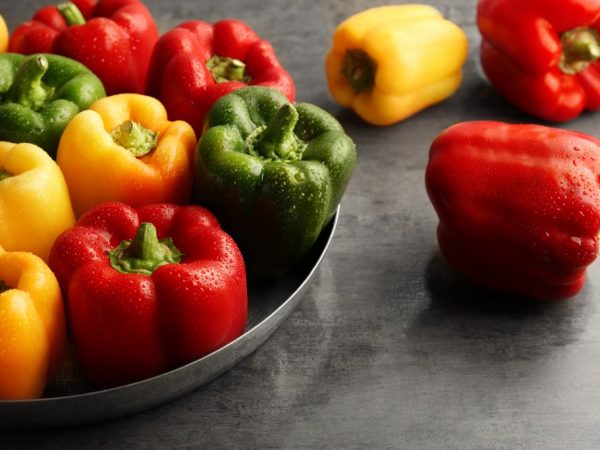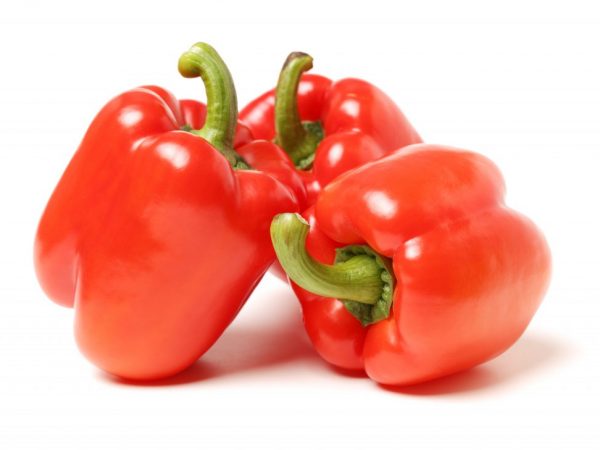Description of pepper Star of the East
Everyone who is fond of growing vegetables in vegetable gardens will appreciate the Star of the East pepper. This variety attracts attention not only with its high yields, but also with an abundance of colors.

Pepper Star of the East
Variety characteristic
The variety was developed by the Russian company Sedek. The culture was bred at the beginning of the XXI century. In 2003, it was entered into the State Register of the Russian Federation.
This F1 hybrid is ideal for growing in all regions of the country. In the central and northern regions, planting is carried out in greenhouse conditions, and in the southern regions, plants are grown in open ground. The yield is high: from 1 sq. m collect 8 kg of selected high quality products.
Description of the bush
The growing season is 110-120 days, and the growing season is indicated before the onset of technical maturity. Biological ripeness occurs 10-12 days after the specified period.
The height of the bushes reaches 80 cm. Each bush has a large number of dark green leaves. The bush has a powerful root system. The main stem contains a large number of fibers that prevent the bush from breaking under heavy loads.
Description of the fetus
- at the time of technical ripeness, the color of the fruit is light beige;
- with the onset of biological ripeness, the color changes from white to deep purple;
- the shape of the sweet fruit resembles a cube or a star;
- wall thickness - 7 mm;
- the average weight of a ripe Bulgarian fruit is 170 g;
Harvesting is possible from the moment of the onset of technical ripeness, because sweet fruits can ripen not on the bushes, but in the storage room. The taste is rich, sweet. There is a large amount of vitamins and minerals useful for the human body. The Star of the East belongs to universal cultures. Its fruits are consumed fresh, and various dishes are prepared or preserved.
Varieties by fruit color

The color of the peppers may vary.
There are several types of the variety in question: purple, giant yellow, giant chocolate, golden and even white stars. Sometimes there are mixtures of different shades (white with red or purple).
It is the mixed categories that attract attention, because they can turn an ordinary vegetable garden into a flower garden. Monochromatic bright varieties are often grown, because they bring a greater yield. According to gardeners' reviews, the orange and purple forms have high yields. They can bear up to 10 kg of fruit per 1 sq. m. Consider the most popular types.
- Yellow and Mandarin variety. The yellow and orange varieties of this series are believed to be early crops. The growing season is about 110 days. Fruits begin to form amicably, so you need to pay attention to the fruiting process. Since the fruits of the yellow and orange series are heavy, their weight is 350 g, they must be harvested immediately after ripening.This procedure will preserve the appearance of the bell pepper bushes. The surface of the fruit is glossy. The orange and yellow star of the f1 category are characterized by excellent yields. Thanks to large, heavy fruits, the yield is 10 kg per 1 sq. m.
- The eastern star is red. The red variety belongs to the early varieties. Full maturation occurs already on the 105th day. Cultivation is possible both in greenhouse conditions and in the open field. The average weight of a single fruit is about 300 g. The taste is rich and sweet. According to the description, the red series has a lot of calcium and iodine, so it is very beneficial for the human body. The yield is high. About 18-20 fruits are harvested from each bush.
- Giant Chocolate - medium ripeness hybrids. Their ripening period is 130 days. The height of the bush is 0.9 m, fruits weighing 0.3-0.4 kg. About 8.5 kg of pepper is collected from each square meter.
- The Violet Star of the East surprises with its deep color and brightness. This vegetable is not afraid of adverse weather conditions. Early ripeness variety, ripens in 100-110 days. The weight of one fruit is about 200 g. The taste is neutral: there are no bitterness and sweetness.
- White Star is a strong and vigorous plant. On each bush, about 8-10 fruits of a white, slightly creamy shade ripen.
Varieties of the East Star have identical requirements for care and disembarkation.
Growing seedlings
Those who decide to grow peppers Star of the East of category f1 should choose the right planting material. It is preferable to choose only packages released on the market last year. It is believed that this year's seeds are less productive.
Before planting seeds, they should be treated with manganese solution and special growth stimulants. This will kill all bacteria and germs, and will also increase seed germination. The soil for planting is chosen light and loose. A low acid-base balance is also important. It should not exceed the 4% mark, otherwise the land is treated with lime.
2/3 of the earth is poured into the container, small rows are made. The distance between them should be kept at 5 cm. The seeds are planted at a distance of 2 cm from each other. The planting depth is 1 cm. After that, the containers are covered with plastic wrap and placed in a room with a constant temperature of 25 ° C. Every day, the seeds are aired, opening the film for half an hour. Watering is also carried out with warm water if the soil is dry. As soon as the first pair of leaves has appeared on the seedlings, it is transplanted to a permanent place.
Landing in a permanent place

Pepper loves warmth
In late spring, it is possible to plant seedlings in a permanent place. Here it is important to pay attention to the landing site. In the greenhouse, transplanting is harvested already in early May. Seedlings are transplanted into open ground only after 20 numbers, because the soil must warm up to the optimum temperature (16 ° C).
Planting in a greenhouse, according to the characteristics, is carried out according to the following principle:
- the distance between the rows is 30 cm, and between the bushes - 50;
- planting depth - 2 cm;
- greenhouse plants are aired daily: the maximum temperature in the greenhouse must be maintained at 28 ° C. If it rises, the greenhouse shelter is ventilated: this allows the plants to get the right amount of air and normalize their development.
When planted in open ground, the Zvezda Vostoka pepper variety of category f1 is characterized by a different planting pattern. The distance between the bushes is 50 cm, and between the holes 70 cm.The planting depth is 3 cm.
Care
Watering should be carried out with warm, settled water and only in the morning. This allows moisture to be retained inside the soil rather than being evaporated by the sun's rays. The regularity of watering is 1 time per 4 days. After each watering, the soil is loosened and weeds are removed. To save time, it is permissible to mulch the space between the bushes.This will allow moisture to remain in the soil longer and prevent weed growth. For mulch, straw mixed with humus is used.
Top dressing is carried out only 3 times during the entire growing season. Before the formation of ovaries, fertilizer is applied twice:
- The first feeding is carried out 2 weeks after planting, using nitrogen fertilizers. This is necessary for the quick and correct growth of the bush.
- The second feeding, using potassium and phosphorus, is carried out at the age of 50 days.
- The third top dressing using superphosphate is carried out during the fruiting period: this drug can enhance the taste of sweet pepper.
If the bush is actively gaining growth, you need to immediately carry out tying the plants to the support, because under the weight of the fruit the bush breaks and stops bearing fruit. It is better to keep nitrogen fertilizers to a minimum, because it is they that provoke active growth.
Diseases and pests
Bell peppers are characterized by a good immune system. Pepper is not susceptible to diseases such as powdery mildew, verticillosis and tobacco mosaic.
Also, this variety of pepper is not susceptible to the influence of pests, which means that caring for the crop becomes even easier.
Conclusion
If you follow all the recommendations, it will turn out on your own, without much effort, to grow tasty and healthy sweet bell peppers of the Star of the East series.


